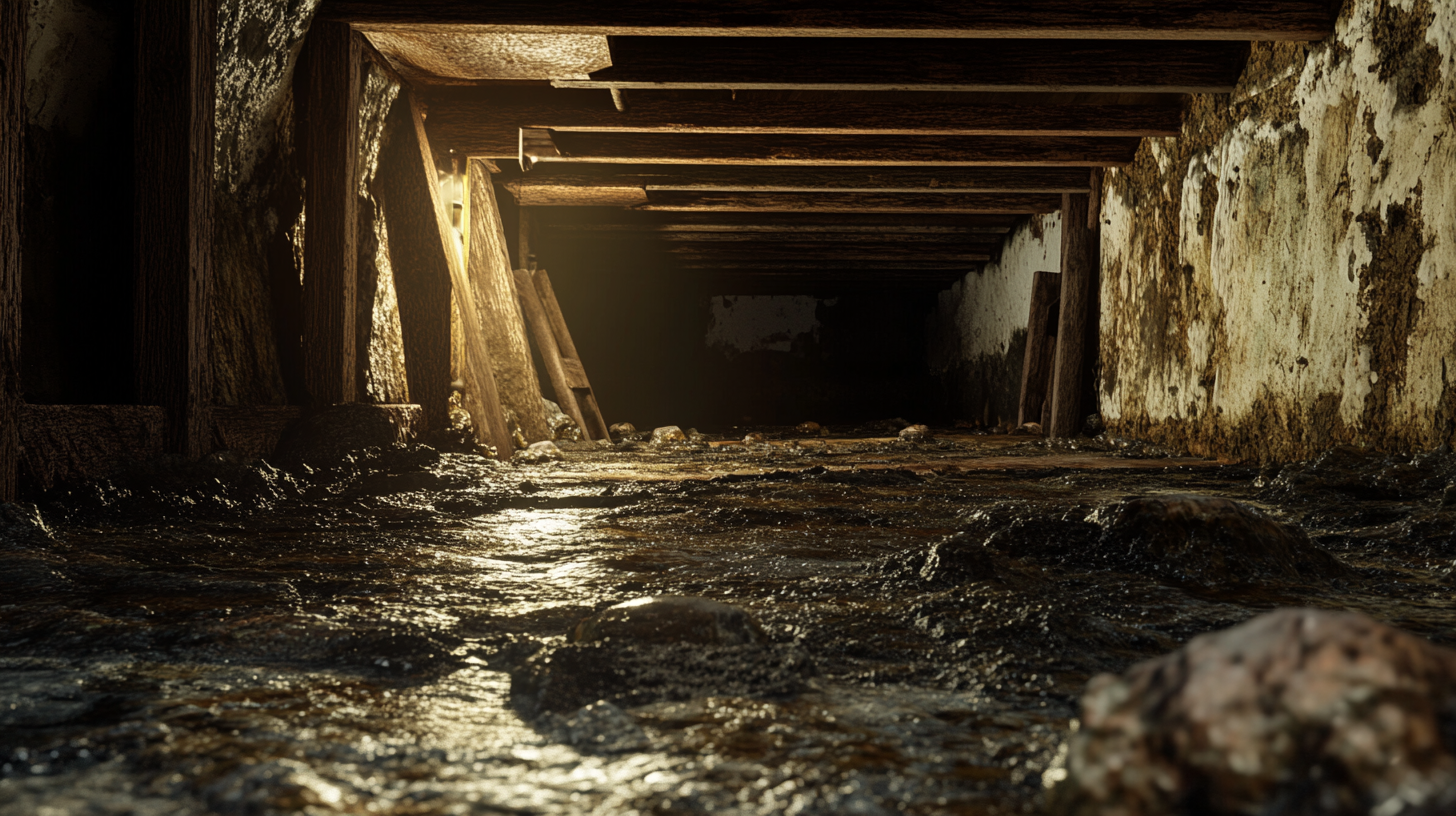Now IS THe Time To...

Crawl Space Services In Knoxville, TN
Stetson Howard: 865-432-6743
CRAWL SPACE ENCAPSULATION, REPAIR, WATERPROOFING & MOLD REMOVAL
No-Obligation, Free Inspections
No-Obligation Free Estimates
We Warranty All of Our Work
100% Satisfaction Guaranteed
In the intricate ecosystem of a home, where every element plays a pivotal role in ensuring comfort and safety, the sump pump emerges as an unsung hero in the realm of water management. Nestled quietly in the lower recesses of homes, particularly in basements and crawl spaces, sump pumps stand vigilant against the encroaching threat of water damage. This blog delves into the critical significance of sump pumps, exploring their indispensable role in maintaining the integrity and dryness of our living spaces.
Water, in its relentless pursuit, finds its way into our homes through the path of least resistance, threatening to inundate basements, compromise structural foundations, and foster the growth of mold and mildew. Herein lies the valor of the sump pump—a device ingeniously designed to counteract these forces by efficiently managing and redirecting unwanted water away from our homes. Whether it's the aftermath of a torrential downpour, the rapid melting of snow, or a high water table's constant pressure, sump pumps operate tirelessly to avert potential crises.
The significance of sump pumps extends beyond their immediate function of water removal. They are pivotal in preserving the health of a home's foundation, preventing the insidious creep of moisture that can lead to costly repairs and renovations. Moreover, by keeping basements dry, sump pumps protect the invaluable possessions stored within and ensure that these spaces remain usable, enhancing the overall utility and value of our homes.
As we navigate through the nuances of sump pump types, installation considerations, and maintenance practices, this blog aims to shed light on the vital role these devices play in home water management. For homeowners seeking to fortify their defenses against water damage, understanding the significance of sump pumps is the first step toward ensuring a dry, safe, and comfortable living environment.
Understanding Sump Pumps
In the quest to maintain a dry and healthy home, especially in areas prone to basement flooding, sump pumps play an indispensable role. These vital devices are engineered to manage water accumulation, safeguarding homes from the potential perils of water damage. This section introduces the basic concept of a sump pump, outlines its critical role in home maintenance, and provides a quick overview of the different types of sump pumps available, including submersible, pedestal, and battery backup models.
What is a Sump Pump?
Basic Definition and the Role of a Sump Pump in Preventing Water Damage
A sump pump is a specialized device installed in the lowest part of a basement or crawlspace, designed to prevent flooding by automatically removing accumulated water. Situated in a sump pit, the pump activates when the water level rises to a predetermined point, efficiently pumping the water out and away from the home's foundation through a discharge pipe. This process is crucial for preventing water from undermining the structural integrity of the house, protecting basements and crawlspaces from flooding, and mitigating the risk of mold and mildew growth associated with persistent moisture.
Types of Sump Pumps
Quick Overview of Different Sump Pump Types (Submersible, Pedestal, Battery Backup)
- Submersible Sump Pumps: These pumps are designed to operate fully submerged in water. They are installed inside the sump pit, making them less obtrusive and quieter than other types. Submersible pumps are highly efficient and ideal for homes that experience significant water accumulation.
- Pedestal Sump Pumps: Featuring a motor mounted above the sump pit, pedestal pumps have an impeller at the base that pumps the water out. The motor itself is not designed to get wet, which allows for easier maintenance and a longer lifespan. These pumps are suitable for smaller pits and less severe water conditions.
- Battery Backup Sump Pumps: Battery backup pumps are designed to take over in the event of a power outage or primary pump failure. They provide an additional layer of security, ensuring that your basement remains dry even during electrical failures or extreme weather conditions.
Understanding the different types of sump pumps and their specific advantages allows homeowners to make informed decisions tailored to their unique needs, ensuring the best possible protection against water damage.
Pre-Installation Planning
Before embarking on the installation of a sump pump, a crucial step in fortifying your home against water damage, thorough planning is essential. This phase involves assessing your specific needs to choose the most suitable sump pump and gathering all necessary tools, materials, and safety gear for the installation process. This section guides you through these preliminary steps, ensuring you are well-prepared to create an effective water management system for your home.
Assessing Your Needs
Factors to Consider When Choosing a Sump Pump (Basement Size, Water Table, Flood Risk)
Selecting the right sump pump requires a careful evaluation of several key factors:
- Basement Size: The size of your basement or crawl space influences the capacity of the sump pump needed to efficiently manage water removal.
- Water Table: Homes situated in areas with high water tables may experience more frequent water accumulation, necessitating a more robust sump pump solution.
- Flood Risk: Assess the historical flood risk of your area, including any past incidents of water intrusion in your home. This will help determine the level of protection you need from your sump pump system.
Understanding these factors will guide you in choosing a sump pump that meets the specific demands of your home, ensuring optimal performance and protection against flooding.
Gathering Necessary Tools and Materials
Comprehensive List of Tools, Materials, and Safety Gear Needed for Installation
Proper installation of a sump pump requires an array of tools, materials, and safety equipment. Here's a comprehensive list to get you started:
- Tools: Drill with concrete bits, saw (hand saw or power saw for cutting pipes), screwdriver, pliers, level, pipe cutter (for PVC discharge piping), and a shovel or jackhammer (for creating or modifying the sump pit).
- Materials: Sump pump (submersible or pedestal, based on your assessment), sump pit or basin, discharge piping (PVC or flexible hose), check valve, and sealants or PVC cement for securing connections.
- Safety Gear: Safety goggles, gloves, dust mask (especially if working with concrete), and ear protection (if using loud power tools).
Having all necessary tools and materials at hand before starting the installation ensures a smoother process and helps prevent delays. Additionally, wearing appropriate safety gear is crucial to protect yourself from potential hazards during the installation.
Step-by-Step Sump Pump Installation
Installing a sump pump is a critical measure to protect your home from water damage, especially in areas prone to flooding. This comprehensive guide provides a step-by-step approach to installing a sump pump, from preparing the sump pit to setting up the discharge system. By following these detailed instructions, homeowners can ensure their sump pump is installed correctly and efficiently.
Preparing the Sump Pit
Instructions on Locating and Digging the Sump Pit
- Location: Identify the lowest point in your basement where water naturally collects. This is the ideal spot for your sump pit.
- Digging: Using a jackhammer or shovel, dig a pit wide and deep enough to accommodate your sump basin. The standard size should allow for at least 6 inches of gravel beneath the basin and around its sides.
Tips for Proper Pit Lining and Gravel Placement
- Lining: If not using a pre-formed basin, line the pit with fabric to prevent soil from mixing with the gravel and water.
- Gravel Placement: Fill the bottom of the pit with about 6 inches of coarse gravel. This aids in water filtration and helps stabilize the pump.
Installing the Sump Pump
Step-by-Step Guide on Placing the Pump, Attaching the Discharge Pipe, and Securing the Pump
- Placing the Pump: Set the sump pump (submersible or pedestal) into the basin, ensuring it sits level on the gravel bed.
- Attaching the Discharge Pipe: Connect the discharge pipe to the pump's outlet. Use PVC cement for PVC piping or secure flexible hose connections with hose clamps.
- Securing the Pump: For pedestal pumps, secure the pump upright according to the manufacturer's instructions. For submersible pumps, ensure the float switch is unobstructed and can move freely.
Setting Up the Discharge System
Guidelines for Routing and Securing the Discharge Pipe
- Routing: Lead the discharge pipe from the pump towards the exterior of your home. Ensure the pipe slopes downward to aid in water flow and prevent backflow.
- Securing: Use pipe hangers to secure the pipe along walls or joists, ensuring it is firmly in place and has a clear path to the discharge point.
Importance of a Check Valve and How to Install It
- Check Valve: This one-way valve prevents water from flowing back into the pit after being pumped out. It's essential for efficient pump operation.
- Installation: Install the check valve directly above the pump on the discharge pipe. Ensure it's oriented correctly, with the flow direction matching the arrow on the valve. Secure it with hose clamps or PVC cement as appropriate.
Electrical Setup and Safety
The electrical setup for a sump pump is a critical component of the installation process, requiring careful attention to ensure both efficiency and safety. Proper electrical connections not only power the pump but also protect it—and your home—from potential hazards. This section provides an overview of the electrical requirements for sump pump installation, including considerations for GFCI outlets and waterproofing, as well as essential safety precautions for handling electrical components.
Electrical Requirements
Overview of Electrical Setup, Including GFCI Outlets and Waterproofing Considerations
- GFCI Outlets: Ground Fault Circuit Interrupter (GFCI) outlets are essential for any appliance in contact with moisture, including sump pumps. These outlets automatically shut off power if they detect a ground fault or short circuit, providing an important layer of protection against electric shock.
- Waterproofing Considerations: Ensure that all electrical connections, including the plug and outlet for the sump pump, are protected from moisture. Use waterproof covers for outdoor outlets and consider a battery backup system to maintain pump operation during power outages.
- Dedicated Circuit: If possible, connect your sump pump to a dedicated circuit to prevent overloading. This ensures that the pump has a reliable power source and reduces the risk of tripping the circuit breaker during operation.
Ensuring Electrical Safety
Safety Precautions to Take When Dealing with Electrical Components
- Turn Off Power: Before working on any electrical components of the sump pump installation, always turn off the power at the circuit breaker. This prevents the risk of electric shock.
- Use Proper Tools: Employ insulated tools when working on the electrical setup to provide an additional layer of protection against accidental electrical contact.
- Check for Water: Never work on electrical components in wet conditions. Ensure the area around the sump pump and electrical outlets is dry before beginning work.
- Professional Assistance: If you are not confident in your ability to safely handle the electrical requirements of the sump pump installation, consider hiring a licensed electrician. Professional installation ensures that your sump pump's electrical setup complies with local codes and safety standards.
Testing and Troubleshooting
After installing a sump pump, conducting an initial test and knowing how to troubleshoot common issues are crucial steps to ensure the system operates effectively, providing your home with reliable protection against water damage. This section guides you through the process of testing your sump pump after installation and offers insights into diagnosing and resolving typical problems that may arise.
Initial Testing of the Sump Pump
How to Conduct a Test Run and What to Look For
Testing your sump pump immediately after installation is essential to verify its proper operation. Here’s how to conduct a test run:
- Fill the Sump Pit: Slowly pour water into the sump pit until the float switch activates the pump. Ensure the water is clean to avoid introducing debris into the system.
- Observe the Activation: Watch as the pump activates to ensure it starts without issues and begins pumping water out through the discharge line.
- Check the Discharge: Confirm that water is being expelled from the discharge line outside your home and that it’s directed away from the foundation.
- Listen for Irregular Noises: Unusual sounds, such as grinding or rattling, could indicate a problem with the pump’s installation or a defect in the unit.
Common Issues and How to Troubleshoot
Tips for Diagnosing and Fixing Basic Issues Encountered During or After Installation
Even with careful installation, sump pumps can encounter issues. Here are common problems and troubleshooting tips:
- Pump Doesn’t Activate: Ensure the pump is plugged in and receiving power. Check the circuit breaker and verify the float switch isn’t obstructed. If using a battery backup, check the battery’s charge.
- Pump Runs Continuously: This may be due to a continuously high water table, a stuck switch, or a faulty check valve allowing water to flow back into the pit. Adjust the float switch if necessary and check the check valve for proper operation.
- Insufficient Water Removal: If the pump seems to be working but isn’t removing enough water, verify that the discharge line isn’t clogged and that the pump’s capacity is adequate for your needs. Also, check for leaks in the discharge line.
- Loud Noises During Operation: Noises can be caused by debris in the pump, issues with the impeller, or mechanical failures. Clean the sump pit and pump inlet, and inspect the impeller for damage.
Regular maintenance, including cleaning the sump pit, checking the operation of the float switch, and ensuring the discharge line remains clear, can prevent many common issues. However, if problems persist after troubleshooting, consulting with a professional or considering a replacement may be necessary.
FAQs
Recent Blog Posts
Crawl Space News







